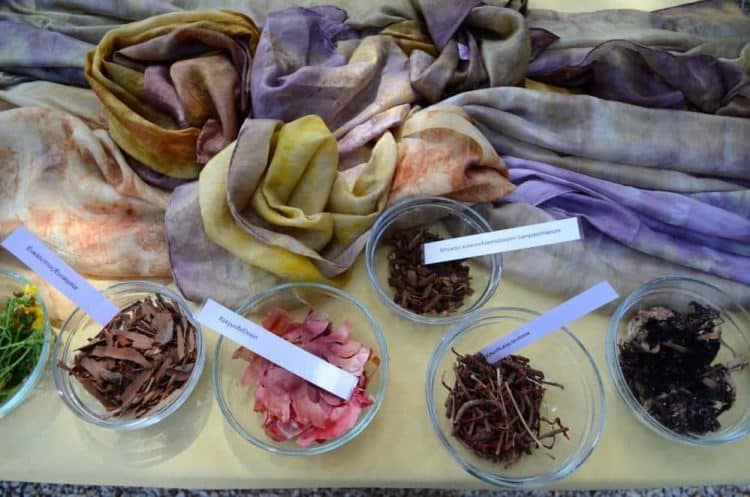You may not be aware, but the debate over synthetic vs natural dyes has been raging since the mid-1800s. At first, the issue was cost. And then, as the state of medical science advanced and began linking synthetic dyes to cancer, the debate shifted to safety. Early synthetic dyes were made from coal tar. Today, synthetic dyes are considered to be safer than they were in the past despite being often designed from naphthalene. But are still a major source of pollution. However, they are cheaper to purchase than their natural counterparts. And they are more effective, longer-lasting, and are currently cheaper to manufacture. Recovering the knowledge and techniques of generating plant-derived dyes from Ethnobotany of Dye Plants would benefit the dye industry and the world today.
The researchers from Southern Italy conducted a survey of the dyeing plants used in the region using techniques from the field of Ethnobotany of Dye Plant. In order to recover the fading or lost knowledge and techniques of generating plant-derived dyes. They compiled a catalog of 440 species of flowering plants, with all but 18 having been historically used for dyes, as well as 72 mushroom and lichen specimens, two of which were not used for dyeing.
Using archival, ethnobotanical, and iconographic works of the region, they extracted dye from each specimen and recorded the data, noting the percentages of color extracted from each part of the specimen plant, such as the stem, leaf, or root.
The results showed that the plants were able to produce dominant colors such as 54% yellow, 17% red, 13% green, 6% brown, 4% blue, 3% black, 2% gray, and 1% purple (Figure 1). The authors noted that the dominance of yellow was not surprising because the range of colors that starts from yellow and turns towards red is obtained mainly from the variety of tannins present in plants in large quantities. The parts of the plants often associated with dyes are stems and leaves, which are high in tannins. Red and yellow were also the two most common colors extracted from mushrooms and lichen (Figure 2).
Recovering the knowledge and techniques of generating plant-derived dyes from Ethnobotany of Dye Plants would benefit the dye industry and the world today. While synthetic dyes may be less expensive, using natural dyes would be a sustainable and eco-friendly alternative. The knowledge from Ethnobotany of Dye Plants could reduce our reliance on harmful chemicals and support a more environmentally conscious textile industry.
Figure 1: The different color breakdowns in plant families reported in the flora of dye plants. At the center of the graph are the percentages of the extracted colors in total. Image taken from Prigioniero A, Geraci A, Schicchi R, Tartaglia MC, Zuzolo D, et al. Ethnobotany of dye plants in Southern Italy, Mediterranean Basin: floristic catalog and two centuries of analysis of traditional botanical knowledge heritage. Journal of Ethnobiology and Ethnomedicine. 2020;16:31, open access.
Figure 2: Total percentages relative to the colors taken from fungi and lichens. Image taken from Prigioniero A, Geraci A, Schicchi R, Tartaglia MC, Zuzolo D, et al. Ethnobotany of dye plants in Southern Italy, Mediterranean Basin: floristic catalog and two centuries of analysis of traditional botanical knowledge heritage. Journal of Ethnobiology and Ethnomedicine. 2020;16:31, open access.
Of the 440 species of flowering plants, researchers were able to find 283 in the field, speculating that a decrease in the number of species of plants may be due to lack of need of plant dyes. As synthetics became popular over the past two centuries. The researchers also considered environmental changes to be a possible factor in the decrease in plant species.
The researchers hope their catalog of hundreds of pigments and colors and their categorized sources will provide a basis for a recovery of an eco-sustainable and economically sustainable natural plant dye industry. Starting in Southern Italy, which would not only impact the dye industry but the environment as well. And with increasing interest in natural dyes as well as sustainable extraction technologies, there is a surmounting opportunity here to reverse decades worth of environmental pollution.
Reference
[1] Prigioniero A, Geraci A, Schicchi R, Tartaglia MC, Zuzolo D, et al. Ethnobotany of dye plants in Southern Italy, Mediterranean Basin: floristic catalog and two centuries of analysis of traditional botanical knowledge heritage. Journal of Ethnobiology and Ethnomedicine. 2020;16:31. [journal impact factor = 3.007; times cited = 4]
Image Source: https://upload.wikimedia.org/wikipedia/commons/b/bd/NATURAL_DYES.jpg













